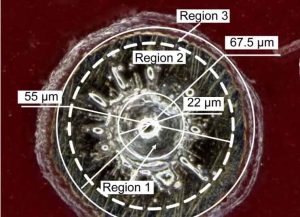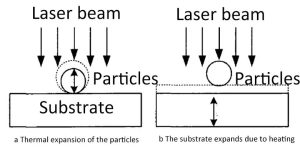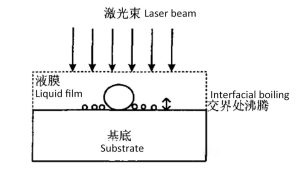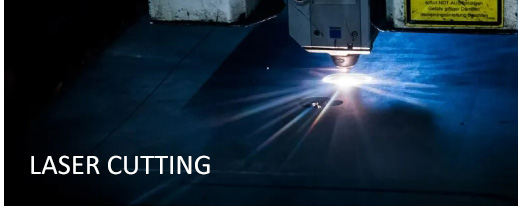Laser cleaning is an effective method for removing contaminants, coatings, and debris from solid surfaces of various materials and sizes. It involves directing a high-brightness and well-directed continuous or pulsed laser, which is focused and shaped into a specific spot size and energy distribution using optical focusing and beam shaping. When the laser beam is directed at the contaminated surface, the attached pollutants absorb the laser energy, triggering a series of physical and chemical processes such as vibration, melting, combustion, and even vaporization. These processes eventually cause the contaminants to detach from the material surface. Most of the laser energy is reflected off the cleaned surface, and the underlying substrate is not damaged, thus achieving an effective cleaning result. Below is an example of aluminum alloy surface cleaning with red paint removal.

Laser cleaning can be classified according to various standards. For instance, it can be categorized based on whether a liquid film is present on the surface of the substrate during the cleaning process. These two categories are: dry laser cleaning and wet laser cleaning. The former involves direct laser irradiation onto the contaminant surface, while the latter requires a thin layer of mist or liquid to be applied to the surface before the laser treatment. Wet laser cleaning is more efficient, but it requires manual application of the liquid film, and the composition of the liquid must not alter the intrinsic properties of the base material. Therefore, compared to dry laser cleaning, wet laser cleaning has some limitations. Dry laser cleaning is currently the most widely used method, in which a laser beam directly irradiates the surface of the object to remove particles and thin films.
Dry Laser Cleaning
The basic principle of dry laser cleaning involves the laser irradiating both the contaminants (particles) and the material substrate. The laser energy is rapidly converted into heat, causing thermal expansion of the particles or substrate, or both. This instantaneous thermal expansion generates a significant acceleration between the particles and the substrate, and the force generated overcomes the adhesive force between the particles and the substrate, causing the particles to detach from the surface.
According to different absorption methods in dry laser cleaning, it can be mainly divided into two types:
- Particles with a higher melting point than the substrate (or significant difference in laser absorption):
- The particles absorb more laser energy than the substrate. The energy absorbed by the particles is converted into heat, which causes the particles to expand thermally. Though the thermal expansion is small, it occurs rapidly, generating a large instantaneous acceleration that acts on the substrate. The reaction force from the substrate acts back on the particles, overcoming the adhesive force between them, causing the particles to detach from the surface.

- Contaminants with a lower boiling point:
- The contaminants directly absorb the laser energy and instantly boil, vaporizing the contaminants and removing them from the surface.

Wet Laser Cleaning Principle
Wet laser cleaning, also known as laser vapor cleaning, is characterized by the presence of a thin liquid or medium film on the surface of the object to be cleaned. The liquid film absorbs the laser energy and its temperature rises sharply, causing the liquid to form bubbles that undergo vaporization and explosion. The explosive force generated by the bubble collapses and overcomes the adhesion between the contaminants and the substrate. Wet laser cleaning can be classified into three types based on the different absorption coefficients of the particle, liquid film, and substrate to laser wavelengths.
- Substrate strongly absorbs the laser energy:
- The laser irradiates both the substrate and the liquid film. When the substrate absorbs much more laser energy than the liquid film, an explosive vaporization occurs at the interface between the substrate and the liquid film. Theoretically, shorter pulse durations lead to greater over-heating at the interface, generating stronger explosive forces.

- Liquid film strongly absorbs laser energy:
- In this case, the liquid film absorbs most of the laser energy, causing explosive vaporization at the surface of the liquid film. This cleaning effect is less efficient than when the substrate absorbs more energy because the explosive force acts on the surface of the liquid film, not directly at the substrate-liquid interface. The explosive force is more effective at removing the contaminants when the energy is absorbed by the substrate.

- Both substrate and liquid film absorb laser energy:
- In this type, the laser energy is absorbed by both the liquid film and the substrate, which results in a lower cleaning efficiency. Some energy is absorbed by the liquid film, causing it to boil and generate bubbles, while the remaining laser energy passes through the film and is absorbed by the substrate. This method requires higher laser energy to induce the vaporization needed for effective cleaning, making it less efficient.

When performing wet laser cleaning with the substrate absorbing the majority of the energy, the interface between the liquid film and the substrate becomes superheated, leading to bubble formation and an explosive force. Compared to dry laser cleaning, wet laser cleaning uses the explosive shockwave generated at the interface to remove contaminants, and it may also involve adding certain chemicals to the liquid film to react with the particles. This helps reduce the adhesion between the contaminants and the substrate, lowering the laser cleaning threshold. Thus, wet cleaning can improve cleaning efficiency to some extent, but it also presents challenges such as potential new contamination and difficulty in controlling the liquid film thickness.
Factors Affecting Laser Cleaning Quality

Effect of Laser Wavelength
The effectiveness of laser cleaning depends on the material’s absorption of the laser light. Therefore, it is crucial to choose a laser wavelength that matches the absorption characteristics of the contaminant and the substrate material. Research has shown that for cleaning contaminants with similar properties, shorter wavelengths result in better laser cleaning performance and lower cleaning thresholds. In summary, to improve cleaning efficiency, lasers with shorter wavelengths should be used, provided they match the absorption characteristics of the material.
Effect of Power Density
Laser cleaning operates within a specific range of power densities: a damage threshold and a cleaning threshold. Within this range, increasing the power density results in stronger cleaning capability and better cleaning effect. Therefore, it is important to maximize the power density without damaging the substrate material.
Effect of Pulse Duration
Laser cleaning can utilize either continuous or pulsed lasers. Pulsed lasers provide high peak power, which can easily meet the required thresholds. Studies have shown that, compared to continuous lasers, pulsed lasers have a smaller thermal effect on the substrate because the heat is concentrated within the short pulse duration, reducing the heat-affected zone on the substrate.
Effect of Scanning Speed and Frequency
In the laser cleaning process, faster scanning speeds and fewer passes can increase efficiency. However, this may lead to reduced cleaning effectiveness. Therefore, it is important to select the appropriate scanning speed and frequency based on the material properties and the contamination level of the substrate. Additionally, the overlap rate of the scanning passes can also affect the cleaning result.
Effect of Defocus
In most cases, the laser beam is focused by a set of lenses before cleaning. However, during actual cleaning, laser beams are typically defocused to increase the spot size and scanning area, improving efficiency. When the total laser power remains constant, a larger defocus results in a larger spot size, reducing the power density, while a smaller defocus increases the power density, improving cleaning capability.







